
Virgilius the Sorcerer is a fairy tale about the poet Virgil by Andrew Lang who included it in The Violet Fairy Book . [1]

Virgilius the Sorcerer is a fairy tale about the poet Virgil by Andrew Lang who included it in The Violet Fairy Book . [1]
Medieval legends attributed magical powers to the poet Virgil, but even among these legends, this tale attributes a very high level of power to him.
Among his accomplishments in the tale, Virgilius is a quick thinker, using his magical powers to defeat corruption and military attacks and spirits. One of his spells was to make an army immobile, turn men to stone, or create a river out of nowhere, encircling them so they could not proceed. Although he wins many challenges, including a magician's battle, wily schemes also help his cause. Among his creations, he invents and animates a horse, rider and dogs out of copper to assert his will.
Virgilius avenges the trickery of his first love for publicly humiliating him before finding true love at last, and creating the city of Naples for her. [2]
The story begins –
Long, long ago there was born to a Roman knight and his wife Maja a little boy called Virgilius. While he was still quite little, his father died, and the kinsmen, instead of being a help and protection to the child and his mother, robbed them of their lands and money, and the widow, fearing that they might take the boy's life also, sent him away to Spain, that he might study in the great University of Toledo.
One holiday, when walking, he came upon an evil spirit that was trapped; the spirit offered him magical books in exchange for setting him free. Virgilius demanded the books, and the knowledge how to use them, first; then he freed the spirit. It grew to an enormous size, so the quick-witted Virgilius declared he did not believe it came out of the hole, and the spirit, to prove it, went back in whereupon Virgilius quickly trapped it again.
He studied magic for many days gaining a wonderful reputation for his powers ("he was much thought of as showing promise of great learning"). This was cut short when his mother sent for him because she was ill and could no longer look after their affairs. When he arrived home, his rich relatives were displeased because his presence meant they could no longer rob their kinsmen. They were, however, related to the emperor, who put off the matter of giving Virgilius his due. His enemies attacked him but Virgilius used his magic to drive them off or cast spells on them. The emperor himself went to him without effect until a magician came into camp and was hired to battle Virgilius. Virgilius had a hard time fighting the magician, but reached the emperor in secret with a proposition: he would stop the fight if he could have justice, compelling the emperor to agree.
Virgilius then fell in love with a woman named Febilla. She told him that she would let him visit her by drawing him up in a basket to a tower. Once he was in the basket, she lifted it only half way, leaving him a dangling target of the crowd's ridicule. The emperor ordered his release, but the next day, no fire in Rome would light. Virgilius told them to bring Febilla to a scaffold in the market place and take fire from her. Fire started about her and she had to stand there until everyone had re-lit their fires. The emperor threw Virgilius into prison with a death sentence, but when he was brought up, thirsty Virgilius asked for water. When the guards brought him a pail of water, Virgilius jumped into it, saying he was going to Sicily and magically vanished.
Andrew Lang has heavily bowdlerized his sources here; in the original Medieval tradition, the fire could only be rekindled from her vagina. The story was very popular with Renaissance artists. The Metropolitan Museum has a Venetian confittiera (ca. 1475–1500) showing Febilla standing on the square with raised skirt, a gift by J. Pierpont Morgan. [3] [4]
The fairy tale says that it is unknown how he reconciled with the emperor, but he next made statues of the gods of every country, including Rome, with bells in their hands, and the bells would ring if they intended treachery toward Rome, so the Romans would send their armies against them.
A country that hated them sent men to Rome; they claimed to be diviners and to have dreamed of gold, and then, with the Senate's permission, dug up the gold they had buried the night before. The third time, they told the Senate it was under the Capitol and they would dig for them, for their generosity; they undermined the Capitol and stole away. Immediately after, the statues fell and were ruined.
Much crime followed in the city. Virgilius had a copper horse and rider made and ordered all men indoors. Only the honest obeyed, and the horse trampled those it found outside. The next day, the surviving thieves tried to use ropes and grapples to stop it, and used rope ladders to escape it. Two copper dogs were added, to jump up and bite them to death.
Virgilius fell in love with a foreign princess, the daughter of a sultan, and carried her away from her father. She was a guest in his house, wondering at the marvels, until she wished to return to her father. Virgilius returned her, but the sultan ordered his death. Virgilius cast a spell on him and his court and carried the princess away again. Then, thinking Rome not fine enough, he built a marvelous city for her, which was Naples.
The technique of tricking spirit is a motif also found in The Spirit in the Bottle and with genies in The Fisherman and the Jinni .
The legend that he had been trapped in a basket was a common medieval tale, warning of the power of love to make fools of men.
There is a reference to the "Black Book" he uses as the source of his spells which in popular culture can be a book containing lists of evil deeds.

In mythology, folklore and speculative fiction, shapeshifting is the ability to physically transform oneself through an inherently superhuman ability, divine intervention, demonic manipulation, sorcery, spells or having inherited the ability. The idea of shapeshifting is in the oldest forms of totemism and shamanism, as well as the oldest existent literature and epic poems such as the Epic of Gilgamesh and the Iliad. The concept remains a common literary device in modern fantasy, children's literature and popular culture.

Giovanni "John" Zatara is a fictional character appearing in American comic books published by DC Comics. He debuted as a superhero, starring in his own stories in Action Comics during the Golden Age of Comics. He first appeared in the first issue.

"The Sorcerer's Apprentice" is a poem by Johann Wolfgang von Goethe written in 1797. The poem is a ballad in 14 stanzas.
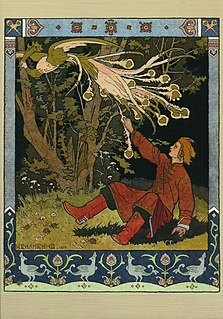
In Slavic mythology and folklore, the Firebird is a magical and prophetic glowing or burning bird from a faraway land which is both a blessing and a harbinger of doom to its captor.

Doctor Clea Strange is a fictional character appearing in American comic books published by Marvel Comics. She is a sorceress and the disciple, lover, and eventual wife of Doctor Stephen Strange, and his ultimate successor as Sorcerer Supreme. Created by co-plotters Stan Lee and Steve Ditko, Clea first appeared in the Doctor Strange feature in Strange Tales #126.
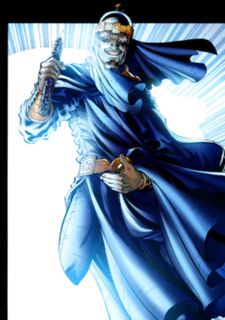
Felix Faust is a supervillain appearing in American comic books published by DC Comics. The character first appeared in Justice League of America #10 (1962), created by Gardner Fox and Mike Sekowsky. He is depicted as an mystic villain connected to the Justice League and its mystic iteration, the Justice League Dark. Commonly portrayed as a malevolent sorcerer obssessed with restoring himself to his former might after being robbed on much of his power during a battle with the Doctor Mist. While typically empowered by the demonic powers of a trio of brothers known as the "Demons Three", whose soul he sold to in a faustian deal, the character also frequently targets other magical entities and objects to strengthen his power, putting him frequently at odds with numerous superhero teams.

A vila is a Slavic fairy similar to a nymph, female, beautiful and with long blonde hair.
A true name is a name of a thing or being that expresses, or is somehow identical to, its true nature. The notion that language, or some specific sacred language, refers to things by their true names has been central to philosophical study as well as various traditions of magic, religious invocation and mysticism (mantras) since antiquity.

The Wonderful Birch is a Finnish/Russian fairy tale. A variant on Cinderella, it is Aarne–Thompson folktale type 510A, the persecuted heroine. It makes use of shapeshifting motifs. Andrew Lang included it in The Red Fairy Book.

The Langs' Fairy Books are a series of 25 collections of true and fictional stories for children published between 1889 and 1913 by Andrew Lang and his wife, Leonora Blanche Alleyne. The best known books of the series are the 12 collections of fairy tales also known as Andrew Lang's "Coloured" Fairy Books or Andrew Lang's Fairy Books of Many Colors. In all, the volumes feature 798 stories, besides the 153 poems in The Blue Poetry Book.

Shita-kiri Suzume, translated literally into "Tongue-Cut Sparrow", is a traditional Japanese fable telling of a kind old man, his avaricious wife and an injured sparrow. The story explores the effects of greed, friendship and jealousy on the characters.
The Hairy Man is a Russian fairy tale. Andrew Lang included it in The Crimson Fairy Book.
The Story of Zoulvisia is an Armenian fairy tale published in Hamov-Hotov, a collection of Armenian fairy tales by ethnologue and clergyman Karekin Servantsians published in 1884. Andrew Lang included it in The Olive Fairy Book. The story was also featured in the book Once Long Ago, by Roger Lancelyn Green and illustrated by Vojtech Kubasta.
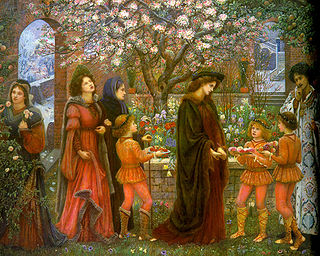
A magician, also known as an enchanter/enchantress, mage, magic-user, sorcerer/sorceress, spell-caster, warlock, witch, or wizard, is someone who uses or practices magic derived from supernatural, occult, or arcane sources. Magicians are common figures in works of fantasy, such as fantasy literature and role-playing games, and enjoy a rich history in mythology, legends, fiction, and folklore.

In folklore and fantasy, an enchanted forest is a forest under, or containing, enchantments. Such forests are described in the oldest folklore from regions where forests are common, and occur throughout the centuries to modern works of fantasy. They represent places unknown to the characters, and situations of liminality and transformation. The forest can feature as a place of threatening danger, or one of refuge, or a chance at adventure.
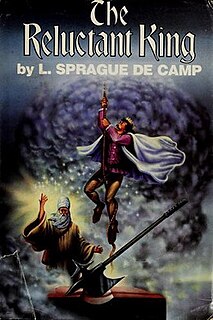
The Novarian series is a sequence of fantasy stories by L. Sprague de Camp, published between 1968 and 1989. The series contains some of de Camp's most innovative works of fantasy, featuring explorations of various political systems, an inversion of the "rags to royalty" pattern characteristic of much heroic fantasy, a satiric look at the foibles of humanity through the eyes of a demon, and a consistently wry and ironic take on conventions of the genre that plays out by taking them to their logical conclusions. Another singular feature of the series is its frequent use of folk tales integrated into the plot to painlessly convey something of the background and history of the invented world. This device obviates the need for lengthy appendices, as in The Lord of the Rings.

Scooby-Doo! and the Goblin King is a 2008 direct-to-video animated comedy horror film, and the twelfth in the series of Scooby-Doo direct-to-video films produced by Warner Bros. Animation. It was dedicated to Paulette Oates, who helped resurrect Warner Bros. Animation in the late 1980s. All the main voice actors of Mystery, Inc. reprise their roles. The DVD was released on September 23, 2008. This is the first Scooby cartoon produced entirely without either one of the original creators, William Hanna and Joseph Barbera.
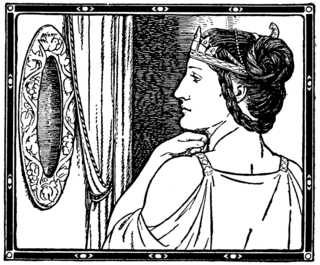
The Magic Mirror is a mystical object that is featured in the story of Snow White, depicted as either a hand mirror or a wall-mounted mirror.
Fairer-than-a-Fairy is a literary fairy tale published anonymously in the 1718 fairy tale collection Nouveaux contes de fées. It is attributed to the Chevalier de Mailly. Andrew Lang included it in The Yellow Fairy Book.

Aladdin's Magic Lamp is a 1967 Soviet fantasy film directed by Boris Rytsarev based on the tale Aladdin from One Thousand and One Nights.